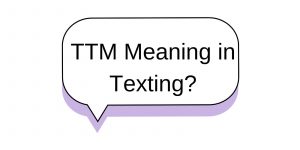In the fast-paced world of digital communication, abbreviations have become an integral part of our conversations. One such abbreviation you might encounter is “TTM.” But what does TTM mean in texting? Let’s break it down and explore its uses, meanings, and context.
What Does TTM Mean in Texting?
TTM stands for “Time to Move.” It is often used in casual conversations, particularly in messaging platforms, to indicate that it’s time to leave a location, start a new activity, or transition to the next phase of a discussion. For example, a friend might text you “TTM” to suggest it’s time to head out for an event or activity.
Which Situations Use TTM in Text Conversations?
You will often see TTM used in informal chats among friends or family. Here are some scenarios where TTM might appear:
- Making Plans: When coordinating activities, someone might say, “It’s TTM, let’s go to the movies!”
- During Events: At a gathering, one person might text another, “TTM, the concert is about to start!”
- In Online Gaming: Players might use TTM to indicate it’s time to move to the next level or strategy, such as “We have to TTM before the enemy arrives!”
Other Meanings of TTM

While “Time to Move” is the most common interpretation of TTM, it can have other meanings depending on the context. For example:
- Talk to Me: Sometimes, TTM can be used to prompt someone to start a conversation or share their thoughts.
- Things to Monitor: In business contexts, TTM can refer to specific metrics or elements that require attention.
Understanding the context in which TTM is used is essential for grasping its intended meaning.
Origin of TTM in Text Communication
The rise of texting abbreviations like TTM can be traced back to the increasing need for speed and efficiency in communication. As texting became more prevalent, particularly among younger generations, users began to create shorthand to convey messages quickly. TTM emerged as part of this trend, fitting into the broader culture of digital communication where brevity is key.
What Should You Know About Using TTM?
When using TTM in conversations, it’s important to consider the following best practices:
- Know Your Audience: Ensure that the person you are communicating with understands the abbreviation. TTM is more likely to be recognized among peers familiar with texting lingo.
- Use in Context: Always use TTM in situations where it fits naturally. Overusing abbreviations can make communication feel less personal.
Which Other Texting Abbreviations Are Similar to TTM?
There are numerous texting abbreviations that serve a similar purpose to TTM. Here are a few:
- TTYL: Talk To You Later – a way to end a conversation while indicating you’ll be in touch again soon.
- BRB: Be Right Back – used to let someone know you’ll be away temporarily but will return.
- LMAO: Laughing My A** Off – used to indicate something is very funny.
These abbreviations, like TTM, enhance the speed and efficiency of communication in texting.
What Impact Does Texting Abbreviations Like TTM Have on Communication?
The use of texting abbreviations can have both positive and negative effects on communication:
- Pros: They allow for quick, efficient exchanges of information, making conversations feel more dynamic and less formal.
- Cons: Over-reliance on abbreviations can lead to misunderstandings, especially if the recipient is unfamiliar with the terms.
Finding a balance between casual shorthand and clear communication is key to effective texting.
Conclusion
In summary, TTM stands for “Time to Move” in texting and is used primarily in casual conversations to indicate it’s time to transition to something new. Understanding TTM and its context can enhance your texting experience, making it more fluid and engaging. As you incorporate abbreviations into your conversations, remember to consider your audience and the clarity of your communication.
FAQs About TTM in Texting
- Can TTM have other meanings?
Yes, TTM can also mean “Talk to Me” in some contexts, depending on the conversation. - Is TTM commonly used in professional communication?
It’s generally more suited for casual conversations, as professional settings typically require more formal language. - How can I learn more texting abbreviations?
Familiarizing yourself with common abbreviations used in texting and online forums can help you understand digital communication better.
Feel free to share your experiences or ask questions about TTM or other texting abbreviations in the comments below!

